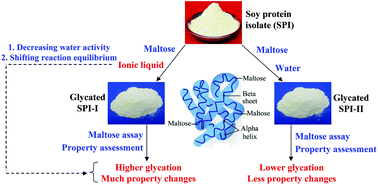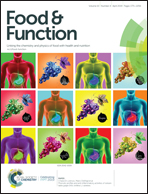Structure and property changes of the soy protein isolate glycated with maltose in an ionic liquid through the Maillard reaction
Abstract
Protein glycation of the Maillard type is successfully applied to modify protein functionalities, mainly using low-water reaction media such as solid-state and wet-heating reaction systems. An ionic liquid (IL) was explored in this study as a promising reaction medium for the maltose glycation of soy protein isolate (SPI) to decrease water activity and to shift the reaction equilibrium. With serial single factor experiments, an SPI concentration of 150 g kg−1, a mass ratio of SPI to maltose of 1 : 1, a reaction temperature of 100 °C, and a reaction time of 2 h were verified to be the suitable conditions for SPI glycation in this IL. Using the four conditions, two glycated SPI products, namely GSPI-I and GSPI-II with maltose contents of 19.88 and 6.26 g kg−1 protein, were prepared with this IL and water, respectively. Compared with the unglycated SPI, both GSPI-I and GSPI-II had many –OH groups, disordered secondary structure, greater protein aggregation with larger hydrodynamic radius (76.7 versus 143.8 and 105.1 nm) and negative zeta-potential (−19.8 versus −20.6 and −20.3 mV) in aqueous dispersion, decreased surface hydrophobicity and in vitro digestibility, increased water-binding (6.69 versus 8.98 and 8.21 g g−1 protein) and oil-binding (2.80 versus 3.11 and 3.09 g g−1 protein) capacities, higher emulsifying activity index (32.4 versus 56.5 and 40.9 m2 g−1 protein) and emulsion stability index (58.4% versus 86.8% and 69.3%), reduced thermal stability with lower decomposition temperature (297.1 °C versus 289.1 °C and 292.9 °C), larger total mass loss (50.3% versus 57.7% and 51.3%), and smaller enthalpy change (9.9 versus 4.4 and 7.2 kJ g−1). In general, GSPI-I always showed greater change in these important properties than GSPI-II, suggesting that the SPI glycation in this IL brought about greater property modification than that in water. This IL is thus verified as an interesting medium for protein glycation to increase glycation extent and to change product properties efficiently.



 Please wait while we load your content...
Please wait while we load your content...